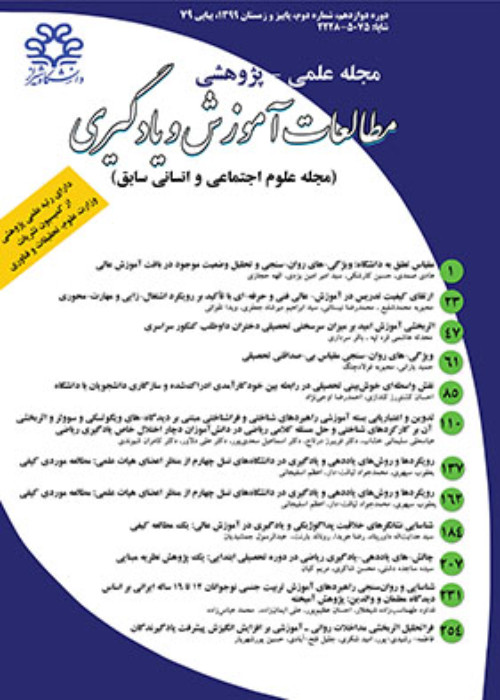Investigating the Performance of Eighth-grade Students in Mathematical Problem Posing
Author(s):
Abstract:
Introduction
For years, problem solving was considered as the ultimate goal of mathematics teaching and learning. Nowadays, there is a consensus among mathematics teachers and educators that mathematical problem solving should be part of each student's mathematical experiences. Over the time and upon an increase in the importance of fostering and progress in higher-order thinking skills such as creative thinking in education, problem posing skill and benefits of utilizing problem posing in the teaching-learning processes and assessment activities have also attracted the attention of mathematics educators.However, providing students with opportunities to experience the mathematical problem posing has not been seriously met. Specially, according to the author's experience, problem posing activities in math curriculum and textbooks of Iran are rarely addressed.Hence, it seems that in our country, the potential of the problem posing tasks in math classes has not been utilized. Obviously, adding the problem posing activities into the curriculum requires serious and extensive studies. It would be better that studies start with gaining an understanding of students and teachers’ level of understanding of the mathematical problem posing and their competency in applying it.The aim of this study was to explore the performance of eighth-grade students in situations where they are asked to pose mathematical problems and their reactions to these situations.It is hoped that this study and other studies in the field would help teachers and students in our country to benefit from mathematical problem posing in math classes properly.Research questions1) How is the performance of students in mathematical problem posing situations?2) How are the student's reactions to different mathematical problem posing situations? and which situations do they prefer?Methods
The research method employed in the study was qualitative in the form of analytical-descriptive content analysis. Sixty five eighth-grade male students in Baqer-shahr took part in the study. Convenient sampling was used in this regard. In order to collect the data in this study, a problem posing test based on Astoyanova and Ellerton’s (1996) test, which included three problem posing situations (structured, semi-structured and free), was given to the participants. In order to investigate the participant's performance more accurately, based on a preliminary study of problems posed by students, a framework for assessing problem posing skills was designed. To find out more about the participant's reactions when faced with problem posing tasks and the situations that they prefer, a questionnaire including three items was administered to 32 of the participants.Results
Investigating the problems posed by the students revealed that the students outperformed in structured problem posing situations compared to the semi-structured and free situations. But the overall performance in mathematical problem posing was very weak. In Semi-structured situations 84% and in the free situations 65% of the students had not posed any proper problem. Also, most of the posed problems by the students were duplication of the problems in their textbook. This shows their dependency on textbooks and their lack of adequate experience in posing new ideas and problems, which could be due to the lack of opportunity for fostering divergent thinking. Regarding the questionnaire, most students reported that it was the first time they faced such situations and therefore were confused as a result of fear and anxiety. Also, most of them preferred structured problem posing situations as compared to the other two situations.The results of this research in line with those of other studies indicate that the main reasons accounting for severe weaknesses in the performance of students are:(1) The absence or lack of opportunities for students to practice problem posing, (2) Relying on the teacher and the textbook to provide questions, (3) Lack of adequate confidence in and knowledge of posing a mathematical problem, (4) Rote-learning and procedural understanding rather than conceptual understanding, (5) Lack of opportunities to improve creativity and flexibility in order to pose new problems, and (6) Lack of awareness among teachers about the benefits of problem posing in teaching-learning processes and evaluation.Discussion
According to the author's experiences, in most of math classes there are not enough meaningful opportunities for students to pose problems and improve their abilities and creativity in this area. By providing opportunities for students to pose problems, we can attain perceptions about the depth of their understanding of content, find out about their strengths and weaknesses, and augment their creativity and innovation skills. Also, it is obvious that when the student's mind is challenged to pose a new problem they gain deeper and more meaningful understanding of the subject. Thus, it seems that the process of problem posing is helpful and even necessary in teaching math. Those involved in education not only should not simply ignoreit, but also should have more knowledge about the nature of this subject and its potentials. They should add problem posing to textbooks and activities in math classes in a reasonable and efficient manner.It should be noted that the successful and effective implementation of problem posing in math classes in the first stage needs trained teachers in this area so that before performing such activities they themselves have enough experience in guiding and leading activities.However, before applying problem posing to math classes, to identify the various aspects of the subject and its relationship to other areas of education, further studies in this area is necessary. Such studies can be conducted at different levels from primary school to university, and even among teachers with such concerns as: investigating the relationship of mathematics problem posing skills with mathematical problem solving ability, the relationship between the student's mathematical content knowledge and their problem posing skills, knowledge of teachers about benefits of problem posing and how to use it in the training process, proper and effective implementation method of the problem posing activities in the classroom, etc.Through these we can gain a deeper understanding of the problem posing process and how it could be realized to guide us in the proper and goal-oriented implementation of it in teaching and assessing mathematics.Keywords:
Language:
Persian
Published:
Studies in Learning & Instruction, Volume:6 Issue: 1, 2014
Pages:
67 to 93
magiran.com/p1365393
دانلود و مطالعه متن این مقاله با یکی از روشهای زیر امکان پذیر است:
اشتراک شخصی
با عضویت و پرداخت آنلاین حق اشتراک یکساله به مبلغ 1,390,000ريال میتوانید 70 عنوان مطلب دانلود کنید!
اشتراک سازمانی
به کتابخانه دانشگاه یا محل کار خود پیشنهاد کنید تا اشتراک سازمانی این پایگاه را برای دسترسی نامحدود همه کاربران به متن مطالب تهیه نمایند!
توجه!
- حق عضویت دریافتی صرف حمایت از نشریات عضو و نگهداری، تکمیل و توسعه مگیران میشود.
- پرداخت حق اشتراک و دانلود مقالات اجازه بازنشر آن در سایر رسانههای چاپی و دیجیتال را به کاربر نمیدهد.
In order to view content subscription is required
Personal subscription
Subscribe magiran.com for 70 € euros via PayPal and download 70 articles during a year.
Organization subscription
Please contact us to subscribe your university or library for unlimited access!




